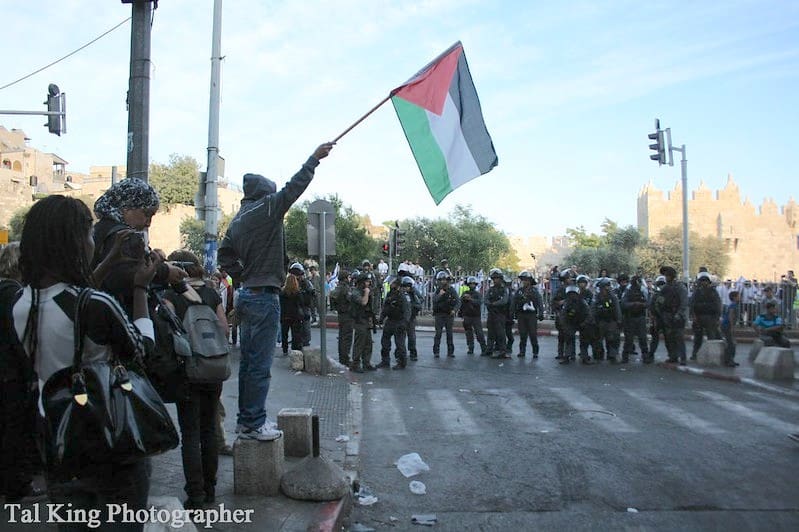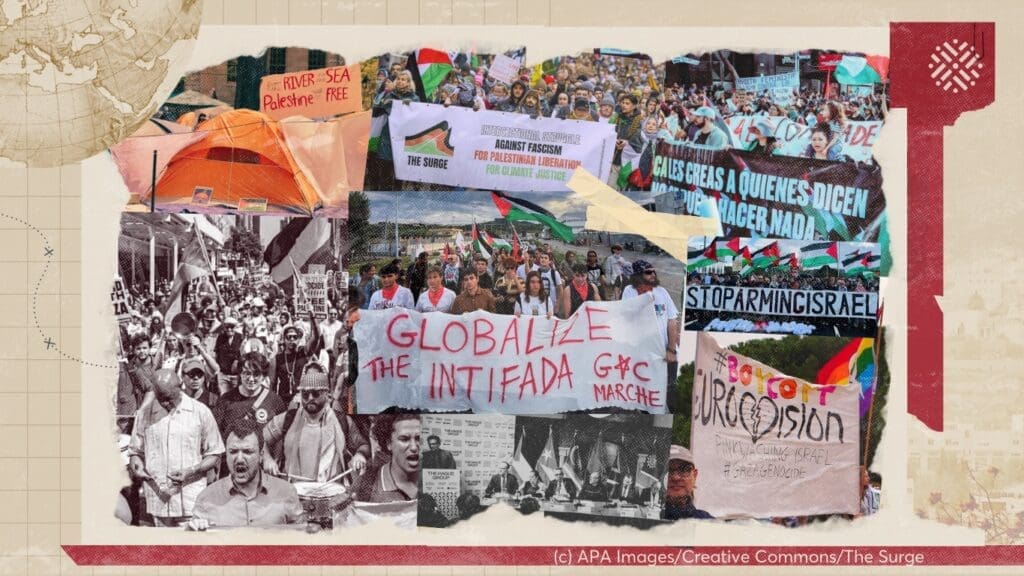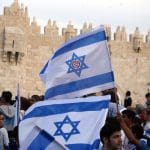
Overview
Even before the crusades, Jerusalem has had an enchanting hold on people’s imagination. Visitors imposed their aspirations, inner anguish, and dreams on what they saw as an eternal sacred city, whereas the worldly city was at great variance and often in contradiction with these imageries. Indeed, this vision of the city of God has always been in contrast with the living physicality of the city. As revealed in the leaked “Palestine Papers,” this view of the metaphoric Jerusalem has been adopted in the negotiations between Israelis and Palestinians.
In this policy brief, Al-Shabaka policy advisor Salim Tamari examines the historical origins of the sacrilization of Jerusalem and how it has obscured changes on the ground affecting the city’s current state and its future. He argues that proposals for the future of Jerusalem ignore the fact that at its core the conflict over the city is a case of colonial subjugation which must be addressed and resolved equitably.
Jerusalem and the “Palestine Papers”
The “Palestine Papers” revealed that Jerusalem occupied a central position in the implicit agreements between President of the Palestinian Authority (PA) Mahmoud Abbas and Israeli Prime Minister Ehud Olmert.1 They demonstrate that the PA has moved considerably from positions held at and since the 1991 Madrid Peace Conference. Previous Palestinian and Arab positions on Jerusalem were based on UN Security Council Resolution (UNSC) 242, passed after the June 1967 War. The resolution considers East Jerusalem occupied territory and its status no different from that of the West Bank, Gaza Strip, or the Syrian Golan Heights. Moreover, the “land for peace” arrangement that is at the heart of UNSC 242 also applies to occupied East Jerusalem.
From the official Palestinian perspective, the PLO’s approval of the two-state formula in 1988 “resolved” the status of Jerusalem as the capital of two states — Israel and the prospective Palestinian state. Jerusalem at this stage became the subject of a seemingly symmetrical formula of reciprocal political arrangements. West Jerusalem would be the capital of Israel, and East Jerusalem would be the capital of the Palestinian state.
However, with the signing of the Oslo Accords in 1993, Jerusalem was deferred to final status negotiations, along with borders, settlements, and refugees. During the second stage of negotiations, in the late 1990s, the focus shifted to Jerusalem’s “special status.” This status emanated from its sacred character, the presence of the holy basin, and the interests of other parties, including Jordan, the broader Islamic world, the Europeans, and the Vatican. This removed negotiations over Jerusalem from an issue that could be addressed simply within the rubric of UNSC 242, that is, restoring the territories to their status before the war.
In the wake of the failed Camp David and Taba negotiations in 2000, the battle over the city shifted from a contest over its future to a question of Israeli disengagement from Palestinian East Jerusalem.
Both Faisal Husseini, the PA’s minister for Jerusalem Affairs until his death in May 2001, and David Wasserstein, Professor of History at Vanderbilt University, separately suggested the Rome model established by the 1929 Lateran Treaty as the most appropriate for Jerusalem. Under the treaty, Italy recognized the Holy See’s sovereignty over Vatican City, while Rome was recognized by the Vatican as the capital of Italy. Open access and free movement was granted to the populations of both cities. However, given the continuing conditions of Israeli encirclement, Jerusalem’s status was more akin to divided Berlin than “split” Rome.
From Political to Sacred Spaces
How were the global claims over Jerusalem reduced to fighting over turf and religious administration of the holy places? It occurred as a result of conquest and the consequences of Israel’s occupation in 1967, which led ultimately to the sacrilization of urban claims.
This process began during the British occupation and mandate over Palestine (December 1917 – May 1948). In 1918, Sir Ronald Storrs, the Military Governor of Jerusalem, established the Pro-Jerusalem Society. Through its emphasis on preserving religious antiquities, the Pro-Jerusalem Society promoted the communitarian notion that Jerusalem was a city of three faiths, rather than an urban foundation for citizenship. It also undermined the search for citizenship as the basis for the modern consciousness of urban solidarities — a crucial development in Ottoman society after the democratic constitution of 1908.
Although Zionism initially had a negative attitude toward the “medievalism” of Jerusalem, over time it created a strategic though often conflicted marriage between Jewish affinities to the holy land and its secular anti-clerical ideology. This had two major consequences. First, Jews were removed from the circle of Arab and Palestinian national ethnicity. Second, Jewish esoteric ties to the “Holy Land,” as embodied in the phrase “Next year in Jerusalem,” were now translated into territorial and nationalist yearnings.
A similar convergence was observed in the Arab national movement, in which Arab nationalist sentiments and religious revivalism were mixed. For example, it was strongly visible in the evolution of popular religious festivals like Nabi Musa into nationalist platforms for resisting Zionism and the idea of a Jewish National Home in Palestine.
Several proposals for addressing this predicament evolved from this conception, beginning with the early planning schemes of the British Mandate.2 This was crystallized in the first partition plans of the 1937 Peel Report, developed in response to the 1936 Arab Revolt.
After the Israeli occupation of the city in 1967, the idea of the “Holy Basin,” was a construct created by a number of European social scientists in the 1990s to reduce the territorial contestation of the Palestinian-Israeli conflict to a minimal area of disputation.3 The Holy Basin was defined as Jerusalem’s Old City plus Rachel’s Tomb and the Mamilla Cemetery. The purpose was to de-link the emotive ideological fusing of the sacred territory and the national territory.
The assumption here was that once the religious contestation was confined to the sacred sites, then the parties could address the rest of the territory on the basis of claims that were subject to diplomatic compromise within the contours of “secure borders.” A second assumption was that most sacred sites are located in mutually exclusive domains. Thus, the “problem” of sacred space becomes more manageable.
However, not all religious sites are exclusive. Several sites are claimed by Muslims and Jews, most notably, Haram al-Sharif and the Temple Mount, Rachel’s Tomb, and the Tomb of the Patriarchs. There are Muslim sites which are newly claimed by Jews (Nabi Rubin, Nabi Samuel) and Jewish sites claimed by Muslims (Nabi Ya’coub). There are also putative Jewish sites that are accepted as Muslim (Nabi Musa).
There is a positive side to isolating the sacred environment from the territorial dispute. While it is virtually impossible to isolate the future of Jerusalem from that of the rest of the Arab-Israeli problem, one can treat religious claims in the context of a shared vision. Jerusalem would be a new corpus separatum in which dual nationality and urban citizenship would create a mini entity in the city that could be a future model for the country as a whole. This implies not dual sovereignty, but the suspension of both Israeli and Palestinian sovereignty over the city. The essence of this proposal is internationalization of the city, which the “international community,” but practically the European and the Islamic world, would underwrite.
Applying the Rules of Exclusion
Israel anticipated and pre-empted Palestinian positions through a series of steps it applied to the militarily defeated city after 1967. First, was the creation of a “Greater Jerusalem” by redrawing the boundaries of the city to include Jewish-only settlements (labeled as “neighborhoods”). This process began in 1970 and has been accompanied by deliberately restricting the natural growth of Arab neighborhoods in East Jerusalem.
Second, was the establishment of differential residency rights between Jerusalem and the West Bank, as represented by Blue (Israeli residents), Green (Palestinians from OPT), and Red (security targeted) identification cards. Within the parameters of expanded Jerusalem, the Palestinian inhabitants — denied acquiring Palestinian IDs and passports issued by the PA under the terms of Oslo — continued to have blue Israeli IDs which gave them residency rights but not citizenship rights. Their status was suspended in limbo. Palestinians in the outer periphery, outside the greater Jerusalem area – were given green IDs, which blocked them from entry to the city.
Third, Israel enshrined Jewish demographic superiority in Jerusalem into law. In 1973, a ministerial committee for Jerusalem (known as the Gaphni Committee) established that the ratio of Arab versus Jewish population should not be allowed to exceed 26/73 percent in favor of the Jewish population.4
By 1998, Jerusalem became a city off limits to Palestinians living in the West Bank and Gaza. It became easier for a Palestinian living in Nablus, Ramallah or Bethlehem to go to Istanbul, Paris, London, or Boston, than to visit Jerusalem.
These rules of exclusion were enforced through zoning laws, legal residency rights, building permits, creation of green zones, and finally the construction of the wall, cutting across West Bank territory and virtually annexing tens of thousands of dunums to Israeli control.5 Israeli law separated the population of the outer periphery of the city (Green IDs) from those given to Arabs of East Jerusalem, who acquired residency rights but not citizenship. The Oslo Accords reinforced and legitimized these separations.
Indeed, a major strategic shift in the status of the city occurred after the Oslo Agreement (1993-2000) when a regime of physical segregation of the city from its Palestinian hinterland in the West Bank was consolidated. The seam points of contact between the Palestinian civilian population and the Israeli military was insulated through by-pass roads, checkpoints, “pass documents” (for movements between districts), and Israel’s wall.
This strategic urban disengagement had the major consequence of making civil resistance (in the manner of the first intifada) impossible for the vast majority of Palestinians living in urban and rural enclaves of areas A, B, and C of the West Bank.6 Paradoxically, since for Israel it was meant to be a security measure, it paved the way for increased militarization of Palestinian politics, as well as the use of rockets and suicide operations.
It also placed the Palestinians in the occupied territories outside the political economy of the Israeli state, and condemned Palestinians in Jerusalem to fend for themselves on issues of daily survival. Only the Palestinian citizens of Israel continued to be part of the Israeli social formation. The net result was the ghettoization of Jerusalem.
The Future?
Current models of addressing the future of Jerusalem under occupation tend to be ideal models that have precedents in contested cities divided by war (Berlin, Nicosia) or by religious/ethnic conflict within the same state (Belfast). These models are relevant to the situation in Jerusalem only after the wider territorial issue between Israel and the Palestinians is addressed. Issues of ethnic conflict, shared religious space, open access, dual or single nationality are issues that can only be addressed after colonial exclusivity and control have been resolved.
In the case of Jerusalem the following formats, which have been mentioned above, have been proposed as elements of a concrete proposal for the future of the city:
• The status quo ante, based on the Ottoman protocols of 1852, and guaranteed by the Congress of Berlin in 1878. This principle works if all religious places are exclusively recognized by the other group. The fact that more than one holy place is contested in Jerusalem gave rise to the proposal in the 2000 Camp David negotiations that, in the case of Haram al-Sharif, “sovereignty belongs to God,” while the administration of holy places would adhere to the Ottoman protocols.
• Vertical Division of the Haram al-Sharif, as a solution to Jewish/Muslim contestation. This is a formula proposed in Camp David, and supported by US President Bill Clinton in 2000. In my opinion this proposal is a recipe for disaster since it proposes to give Muslims the surface area, and the Jews access and control over the underground areas of the Haram al-Sharif.
• The Roman Principle assumes two separate sovereignties that have reached an accord. The result is two states, two sovereignties (as in the Vatican and the Italian Republic) but joint administration of the city. This solution assumes that the two parties have reached agreement on the territorial issues and border delineations; it cannot work in reverse.
• The Holy Basin proposal confines the dispute over Jerusalem to the area of the Sacred Basin — in other words the Old City and the area immediately around it (Bethlehem, Mount of Olives and Mamilla Cemetery). In essence it revives the corpus separatum Proposal of the 1947 UN Partition Plan. It aims at reducing the area of Jerusalem and subjecting the rest of the territory to the logic of UNSC Resolution 242. This proposal works if both Israel and the Palestinians accept the internationalization of the city, which is unlikely.
Conclusion
The issue of Jerusalem cannot be resolved in separation from the rest of Arab Israeli conflict. Jerusalem has all the outstanding issues of the Palestinian problem (refugees, property restitution, border delineation, security arrangements) on a smaller scale. However, it is possible to segregate some of these issues and tackle them in a manageable manner as a way of examining their applicability to the conflict as a whole. For example the issues of access to holy places, residency and administrative control can be dealt with in the context of internationalization but only after, or simultaneously with, an agreement on border delineation between Israel and the Palestinians
The problem with both the sacred basin paradigm (leading to shared understandings) and the ethnic conflict paradigm (leading to conflict resolution through compromises like “We are all the children of Abraham”), is that they ignore the most persistent and overwhelming features of the current unequal relations in the city. Namely, that the conflict of the city rests on unequal distribution of resources, lack of parity, and colonial subjection. Only by addressing these issues and rectifying them can the derivative notions of shared religious sites and the idea of an open city be resolved properly.
- See Trilateral Meeting Minutes 15 June 2008, http://transparency.aljazeera.net/document/2825 and Gregg Carlstrom, “The Biggest Yerushalayim,” Al-Jazeera English, 23 January 2011. http://english.aljazeera.net/palestinepapers/2011/01/2011122112512844113.html. ↩
- See Wendy Pullan and Lefkos Kyriacou, “The Work of Charles Ashbee: Ideological Urban Visions with Everyday City Spaces” Jerusalem Quarterly 39 (Autumn 2009): 51-61. ↩
- See a Canadian overview of this theme in Michael J. Molloy, Michael Bell, and John Bell, A Special Regime for the Old City of Jerusalem, Windsor University, 2008, http://www.uwindsor.ca/joci/. ↩
- In 1973, the Israeli government adopted the recommendation of the Inter-ministerial Committee to Examine the Rate of Development for Jerusalem (known as the Gafni Committee), which determined that a “demographic balance of Jews and Arabs must be maintained as it was at the end of 1972,” that is, 73.5 percent Jews, and 26.5 percent Palestinians. Over the years, all Israeli governments, through the Ministerial Committee for Jerusalem, have affirmed that goal as a guiding principle of municipal planning policy, and it has been the foundation of demographic and urban plans prepared by government ministries. See B’Tselem, A Policy of Discrimination: Land Expropriation, Planning and Building in East Jerusalem, Comprehensive Report, May 1995 (eastsidestory.ps/pdf-files/12PolicyofDiscrimination12.doc, accessed June 5, 2011). ↩
- A dunum is the equivalent of 1,000 square meters ↩
- Under the terms of the Oslo Accords related to the West Bank (Oslo II), the territory was divided into three areas: A, B, and C. The Palestinian Authority is responsible for security and has relative autonomy in Area A, and it shares security duties with Israel in Area B. Israel has security responsibilities for Area C, which accounts for nearly 60 percent of the West Bank, and includes Israeli settlements, military bases, Jewish-only road network, checkpoints and the wall. It should be noted that in spite of the relative autonomy enjoyed by the PA in Areas A and B, Israel maintains control over the entire West Bank. ↩








